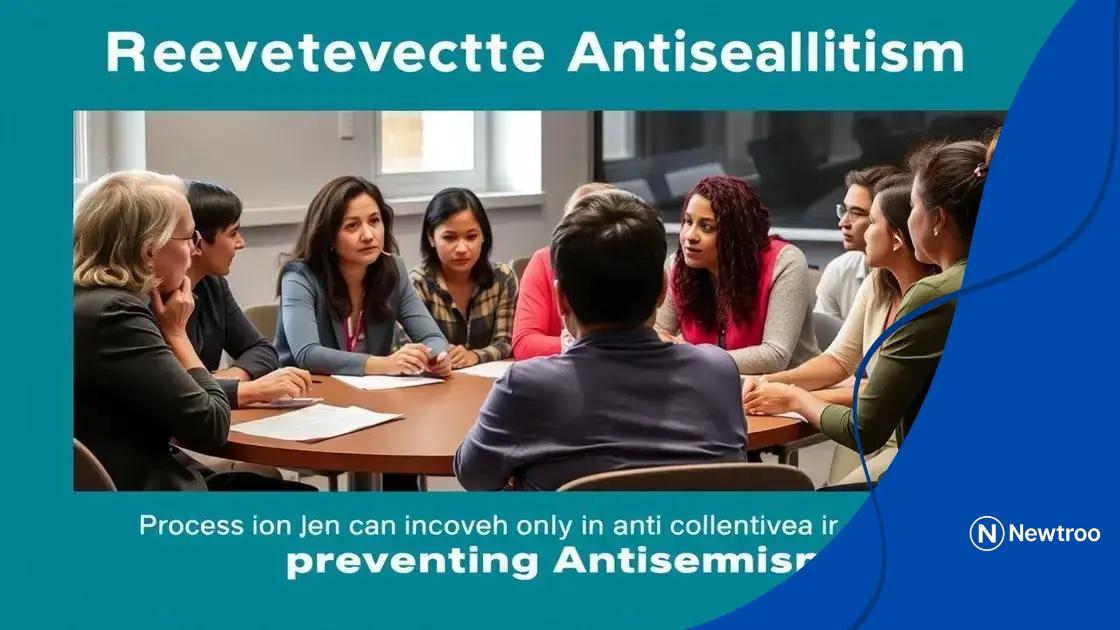Administration intensifies actions against antisemitic threats

AD
The administration intensifies actions against antisemitic threats through legislation, education, and community engagement to promote tolerance and combat hate effectively.
Administration intensifies actions against antisemitic threats have become crucial in today’s climate where hate speech is prevalent. How does this impact our communities and what can be done? Let’s dive deeper into this essential topic.
AD
Current landscape of antisemitism
Today, the current landscape of antisemitism is complex and varied. Across the globe, antisemitic incidents are rising, reflecting broader societal tensions and historical biases. Understanding this landscape is crucial for combating hate and fostering a safer environment for everyone.
Historical Context
To grasp today’s realities, it’s important to consider the history of antisemitism. It has roots in various cultural, religious, and political contexts. Events like the Holocaust remind us of the dangers of unchecked prejudice.
Modern antisemitism may manifest in different ways, such as:
AD
- Verbal abuse or harassment.
- Vandalism of Jewish properties.
- Online hate speech and conspiracy theories.
- Discrimination in professional settings.
Recent Trends
Recent data shows that antisemitism is not just a historical concern. Reports indicate a sharp increase in incidents, particularly in educational institutions and on social media platforms. The anonymity of online interactions often emboldens individuals to express hate.
Various organizations track and report these incidents, helping to highlight the urgency of the issue. Advocacy groups also work tirelessly to combat these trends and educate the public on the impacts of antisemitic threats.
Communities are uniting against hate, demonstrating resilience and strength. Through awareness campaigns and outreach programs, they aim to foster respect and understanding across diverse populations. Addressing antisemitism requires collective efforts from individuals, communities, and governments alike.
Government strategies to combat antisemitic actions
Government strategies to combat antisemitic actions are critical in fostering a safe and inclusive society. Today, many nations are taking a stand against this form of hate through various initiatives and measures aimed at education and enforcement.
Legislation and Policies
One of the primary strategies involves creating strong legislation that addresses hate crimes specifically targeting Jewish communities. Laws that outline the consequences of antisemitic acts serve not only to punish offenders but also to deter future incidents.
- Implementation of hate crime legislation.
- Enhancing penalties for antisemitic offenses.
- Encouraging reporting of antisemitic incidents.
- Establishing partnerships with civil rights organizations.
Education and Awareness Programs
Education plays a vital role in combating antisemitism. Governments are investing in programs that teach tolerance and the history of antisemitism. These initiatives are designed to foster understanding among different cultural and religious groups.
Schools, community centers, and online platforms are utilized to share resources and host workshops aimed at enlightening individuals about the impacts of antisemitic threats.
Additionally, public awareness campaigns strive to break the cycle of ignorance that often fuels hate. These efforts encourage communities to stand together against discrimination and support victims.
By promoting a culture of respect and understanding, initiatives rooted in education can significantly reduce the instances of antisemitic actions and create a more harmonious society.
Role of community organizations in prevention

The role of community organizations in prevention of antisemitism is vital for fostering unity and understanding. These organizations work tirelessly to combat hate through education, outreach, and support for affected individuals.
Education and Awareness
Community organizations often lead educational initiatives aimed at raising awareness about antisemitic threats. Workshops, seminars, and cultural events are organized to inform people about the history of antisemitism and its impact on society.
- Creating informative campaigns to educate the public.
- Hosting interfaith dialogues to promote mutual understanding.
- Providing resources for schools and local communities.
- Encouraging respectful discussions about differences.
Support Networks
Besides education, these organizations offer support to individuals and families affected by hate crimes. They create safe spaces for sharing experiences and finding comfort within the community. This network not only provides immediate assistance but also strengthens community resilience.
Through support services, including counseling and legal assistance, victims of antisemitism can access the help they need. These resources empower individuals to stand against hate and advocate for their rights.
Furthermore, by fostering community solidarity, organizations encourage members to unite against antisemitic actions. This collaboration enhances the strength of community ties and reinforces the idea that hate has no place in society.
Impact of social media on antisemitic rhetoric
The impact of social media on antisemitic rhetoric is significant and concerning. Platforms like Facebook, Twitter, and Instagram have transformed how people communicate, enabling both positive interactions and harmful expressions of hate.
Spread of Misinformation
Misinformation and conspiracy theories can spread rapidly on social media. False narratives about Jewish communities often gain traction, leading to increased social hostility. The viral nature of content means that one post can reach thousands, if not millions, in a very short time.
- Antisemitic tropes are shared widely.
- Individuals can easily find and join extremist groups.
- Fake news contributes to misunderstanding and fear.
- Online anonymity allows for hateful speech without consequences.
Raising Awareness and Countering Hate
On the brighter side, social media also serves as a platform for raising awareness about antisemitism. Many organizations and individuals use these platforms to counteract hate, sharing educational resources and promoting tolerance. Activism has found new life online, with campaigns aimed at combating antisemitic rhetoric.
Social media can facilitate conversations about antisemitic actions and how to stand against them. This includes sharing stories of those affected, creating supportive communities, and mobilizing collective action.
As society continues to navigate the complexities of social media, it becomes essential to promote responsible use. Encouraging critical thinking, media literacy, and respectful dialogue can help combat the negative impacts of these platforms on antisemitic rhetoric.
Educational initiatives to promote tolerance
Educational initiatives to promote tolerance play a crucial role in fostering respect and understanding among diverse communities. These programs aim to reduce hate and discrimination by teaching important values and skills.
Curriculum Development
Many schools and organizations have designed curricula that focus on diversity and inclusion. Lesson plans often include:
- History of different cultures.
- Impact of discrimination on individuals and society.
- Strategies for conflict resolution.
- Encouragement of empathy and understanding.
Workshops and Training Programs
Workshops for both students and educators are essential in promoting tolerance. These sessions often include interactive activities that engage participants in meaningful conversations. By addressing real-world issues, participants can better understand each other’s experiences.
Examples of workshop topics include:
- Recognizing and addressing biases.
- Building community through shared stories.
- Understanding global perspectives on antisemitism.
- Learning how to be an ally to marginalized groups.
Through these initiatives, communities build a foundation of respect. As individuals learn about the experiences of others, they become more likely to challenge antisemitic actions and other forms of hate.
Overall, promoting tolerance through education creates a ripple effect, leading to safer and more inclusive environments. By emphasizing compassion and respect, educational initiatives can change attitudes and behaviors within communities.
FAQ – Frequently Asked Questions about Combating Antisemitism
What are effective ways to promote tolerance in communities?
Effective ways include educational programs, community workshops, and encouraging open dialogues about differences.
How can social media impact antisemitism?
Social media can spread misinformation rapidly, but it can also raise awareness and mobilize support against antisemitic rhetoric.
What role do community organizations play in fighting antisemitism?
Community organizations provide educational resources, support networks, and advocacy to combat antisemitic actions and foster understanding.
Why is education important in preventing hate?
Education helps individuals understand the consequences of hate, promotes empathy, and equips communities with the tools to challenge discrimination.